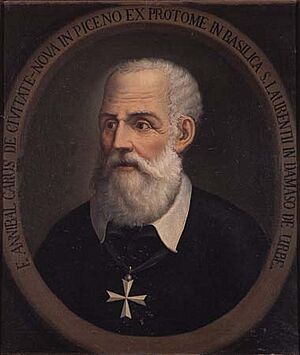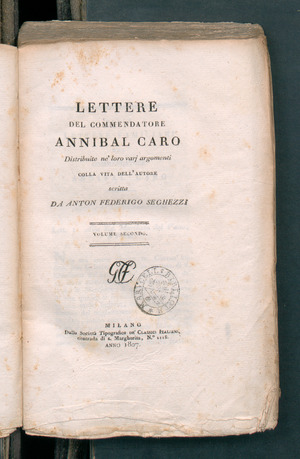Annibale Caro facts for kids
Quick facts for kids
Annibale Caro
|
|
|---|---|

Portrait of Annibale Caro, c. 1562
|
|
| Born | 6 June 1507 Civitanova Marche, Papal States
|
| Died | 17 November 1566 (aged 59) |
| Resting place | San Lorenzo in Damaso |
| Occupation |
|
| Known for | Italian translation of the Aeneid of Vergil |
| Parent(s) | Giambattista Caro and Celanzia Caro (née Centofiorini) |
| Writing career | |
| Language | Italian, Latin |
| Genre | |
| Literary movement | Late Renaissance |
Annibale Caro (born June 6, 1507 – died November 17, 1566) was a famous Italian writer and poet. He lived during a time called the Late Renaissance, which was a period of great art and learning. He is best known for his amazing translations of ancient Roman and Greek stories into Italian.
Annibale Caro's Life Story
Annibale Caro was born in a town called Civitanova Marche in Italy. When he was young, he started working for important families. First, he became a tutor for the wealthy Gaddi family in Florence. Later, he worked as a secretary for Giovanni Gaddi.
After Giovanni Gaddi passed away, Annibale Caro began working for the powerful Farnese family. He became a trusted secretary for important people in this family, like Pier Luigi Farnese and his sons, Ottavio and Cardinals Ranuccio and Alexander. This job allowed him to be close to many influential people of his time.
What Annibale Caro Wrote
Annibale Caro was a very talented writer. His most important works were his translations of famous ancient texts. But he also wrote many other things:
- He wrote beautiful poems and sonnets.
- He wrote a funny play called Gli Straccioni, which means "The Ragamuffins."
- He also wrote some clever and humorous pieces, like La Ficheide, which was a praise of figs. He even wrote a funny eulogy (a speech praising someone) about a local person's big nose!
People admired his poetry because it flowed so freely and gracefully. Many believed he made a style of poetry called verso sciolto (which means "loose verse") the best it could be in Italy. He also wrote many letters for himself and for the Farnese Cardinals. These letters were known for being very polite and elegant.
In 1555, Annibale Caro became a "knight of grace" in the Order of Malta. This meant he was a member of this special order but did not take religious vows.
Annibale Caro passed away in Frascati in 1566. He was buried in the Church of San Lorenzo in Damaso in Rome. Besides his famous translations, he also translated works by important thinkers like Aristotle, Cyprian, and Gregory Nazianzen.
His Famous Translations
Annibale Caro is most famous for his amazing translations. He translated the Aeneid by Vergil, a very long and important poem from ancient Rome. People at the time loved his translation, and many still enjoy reading it today. It helped many Italians read this classic story in their own language.
He also translated Daphnis and Chloe, an ancient Greek novel by Longus. This translation was so good that it remained the standard version for hundreds of years. His work helped bring these old stories to new readers in Italy.
See Also
- Italian literature
- Renaissance literature


